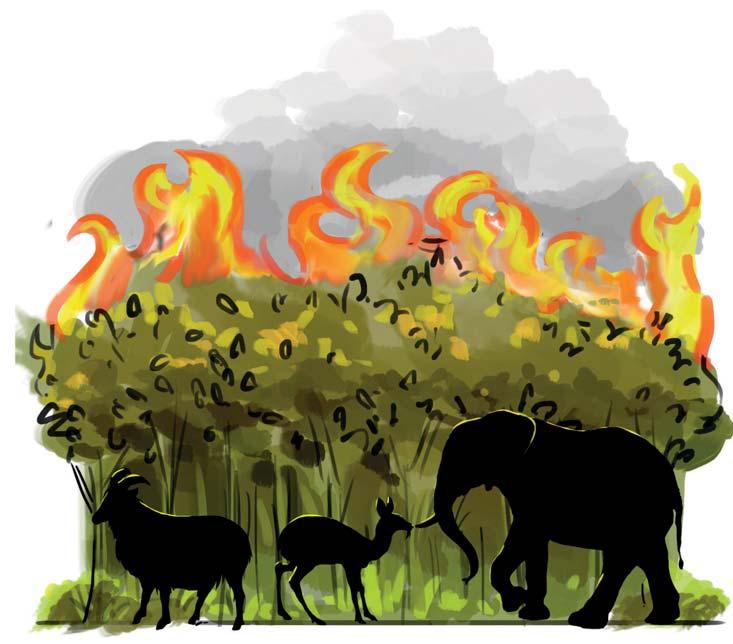कोशिश गोल्ड - मुक्त
Fatal coincidence
Down To Earth
|April 16, 2023
Forest fire season in Uttarakhand coincides with flowering and breeding months of several vulnerable species, many of them native to Himalayas

FOREST FIRES are becoming more frequent and fierce in Uttarakhand. Such regular burnings can be catastrophic for the state as well as the rich biodiversity it harbours. Uttarakhand is home to at least 102 species of mammals, 70 reptiles, 19 amphibians, and 124 species of fish. The state also boasts of 600 species of birds. The International Union for Conservation of Nature (IUCN) classifies 55 of the bird species as "threatened", of which six are critically endangered and four are endangered. Several mammalian fauna found in the state are also classified as endangered. The list includes the Asian elephant, tiger, Alpine musk deer, Himalayan musk deer, leopard, snow leopard, blue sheep, Himalayan Thar, leopard cat, Himalayan black bear, sloth bear and pangolin. With 7,000 species of plants, Uttarakhand contributes 31 per cent of the country's floral diversity. As many as 119 flowering plants are endemic to the state. The impact of recurrent forest fires in Uttarakhand is therefore not limited to the direct loss of trees and wildlife, their displacement and subsequent colonisation of unwanted species.
Forest fires can meddle with the life cycle of species and push many of the threatened and endemic species closer to extinction.
For instance, by destroying the leaves and foliage, a forest fire can significantly reduce the photosynthetic activity of surviving trees and thereby affect their growth. It can also damage the seed bank, both above and below the ground, and wipe out the seedlings and saplings growing on the forest floor. Species that are sparsely distributed and have small or patchy populations suffer the worst impacts as they lose their habitat, territories, shelter and food. The loss of keystone organisms in forest ecosystems, such as invertebrates, pollinators, and decomposers, can significantly slow the recovery rate of the forest.
यह कहानी Down To Earth के April 16, 2023 संस्करण से ली गई है।
हजारों चुनिंदा प्रीमियम कहानियों और 10,000 से अधिक पत्रिकाओं और समाचार पत्रों तक पहुंचने के लिए मैगज़्टर गोल्ड की सदस्यता लें।
क्या आप पहले से ही ग्राहक हैं? साइन इन करें
Down To Earth से और कहानियाँ

Down To Earth
SOME OVERLOOKED ASPECTS
Increasing night-time temperatures and rapid intensification of cyclones already happening
1 min
November 16, 2025

Down To Earth
Excessive groundwater extraction can cause subsidence
Subsidence is a global phenomenon seen not just in coastal regions, but also in inland areas. Natural subsidence progresses slowly, but anthropogenic activities, like excessive groundwater extraction, can significantly accelerate the rate, says LEONARD OHENHEN, assistant professor, department of earth system science, University of California, Irvine, US. In an interview with SUSHMITA SENGUPTA, Ohenhen says that climate change intensifies the problem through multiple pathways.
3 mins
November 16, 2025

Down To Earth
2025 IS UNPRECEDENTED
Never heard about so many such exceptional rainfall events as have occurred this year
1 min
November 16, 2025

Down To Earth
GOVERNING THE CLOUDS
In the absence of evidence, replicability, funding and transparency, cloud seeding languishes as an imperfect science
6 mins
November 16, 2025

Down To Earth
Heavier footprints
Investments and capital owned by the world's wealthiest few are driving the climate crisis, according to a first-of-its-kind report
3 mins
November 16, 2025

Down To Earth
Views on the annual Delhi pollution debate
This is in response to the \"Photo of the day: A game of soccer in post-Diwali Delhi\" published on the website on October 21, 2025.
2 mins
November 16, 2025
Down To Earth
Climate change fuelled hurricane Melissa
ON OCTOBER 28, category 5 hurricane Melissa made landfall in Jamaica with maximum sustained wind speeds of 298 km per hour (kmph), making it one of the strongest hurricanes in the North Atlantic Ocean.
1 min
November 16, 2025

Down To Earth
ICAR's claims exposed by its own data
Why has ICAR flouted crop testing rules and ignored data red flags to push gene-edited rice strains that will not benefit farmers?
4 mins
November 16, 2025
Down To Earth
COMMUNITY RIGHTS BEFORE RELOCATION
Union tribal ministry releases policy document on rights of communities in tiger reserves marked for relocation
2 mins
November 16, 2025

Down To Earth
Stork sanctuary
Villages in Uttar Pradesh mount efforts to protect painted storks and inspire a conservation movement
2 mins
November 16, 2025
Translate
Change font size

